Detection of Internal Holes in Additive Manufactured Ti-6Al-4V Part Using Laser Ultrasonic Testing
Abstract
:Featured Application
Abstract
1. Introduction
2. Experimental Method
2.1. Sample Fabrication
2.2. Laser Ultrasonic Testing
2.3. X-ray Computed Tomography
3. Results
3.1. Laser Ultrasonic Testing
3.2. X-ray Computed Tomography
4. Conclusions
- The amplitude of laser-generated ultrasonic Rayleigh wave attenuated approximately linearly with the increasing internal hole diameter.
- Owing to the diffraction by holes, amplitude of longitudinal waves decreased. Meanwhile, the longitudinal wave may take a longer time to arrive at the top surface of the sample.
- Sub-millimeter holes with a diameter of 0.8 mm was clearly identified in both B-Scan and C-Scan images obtained from the utilized LUT system. Holes with diameters of 1.0 and 2.0 mm were also identified.
Author Contributions
Funding
Acknowledgments
Conflicts of Interest
References
- Zhang, T.; Li, H.; Liu, S.; Shen, S.; Xie, H.; Shi, W.; Zhang, G.; Shen, B.; Chen, L.; Xiao, B.; et al. Evolution of molten pool during selective laser melting of Ti–6Al–4V. J. Phys. D 2018, 52, 055302. [Google Scholar] [CrossRef]
- Shen, B.; Li, H.; Liu, S.; Zou, J.; Shen, S.; Wang, Y.; Zhang, T.; Zhang, D.; Chen, Y.; Qi, H. Influence of laser post-processing on pore evolution of Ti–6Al–4V alloy by laser powder bed fusion. J. Alloys Compd. 2019, 42, 152845. [Google Scholar] [CrossRef]
- Everton, S.K.; Hirsch, M.; Stravroulakis, P.; Leach, R.K.; Clare, A.T. Review of in-situ process monitoring and in-situ metrology for metal additive manufacturing. Mater. Des. 2016, 95, 431–445. [Google Scholar] [CrossRef]
- Tammas-Williams, S.; Zhao, H.; Léonard, F.; Derguti, F.; Todd, I.; Prangnell, P.B. XCT analysis of the influence of melt strategies on defect population in Ti–6Al–4V components manufactured by Selective Electron Beam Melting. Mater. Charact. 2015, 102, 47–61. [Google Scholar] [CrossRef]
- Ziółkowski, G.; Chlebus, E.; Szymczyk, P.; Kurzac, J. Application of X-ray CT method for discontinuity and porosity detection in 316L stainless steel parts produced with SLM technology. Arch. Civ. Mech. Eng. 2014, 14, 608–614. [Google Scholar] [CrossRef]
- Cunningham, R.; Zhao, C.; Parab, N.; Kantzos, C.; Pauza, J.; Fezzaa, K.; Sun, T.; Rollett, A.D. Keyhole threshold and morphology in laser melting revealed by ultrahigh-speed X-ray imaging. Science 2019, 363, 849–852. [Google Scholar] [CrossRef]
- Rieder, H.; Spies, M.; Bamberg, J.; Henkel, B. On-and offline ultrasonic inspection of additively manufactured components. In Proceedings of the 19th World Conference on Non-Destructive Testing (WCNDT), Munich, Germany, 13–17 June 2016. [Google Scholar]
- Rieder, H.; Dillhöfer, A.; Spies, M.; Bamberg, J.; Hess, T. Ultrasonic online monitoring of additive manufacturing processes based on selective laser melting. AIP Conf. Proc. 2015, 1650, 184–191. [Google Scholar]
- Karthik, N.V.; Gu, H.; Pal, D.; Starr, T.; Stucker, B. High frequency ultrasonic non destructive evaluation of additively manufactured components. In Proceedings of the 24th International Solid Freeform Fabrication Symposium, Austin, TX, USA, 12–14 August 2013; pp. 311–325. [Google Scholar]
- Raguvarun, K.; Balasubramaniam, K.; Rajagopal, P.; Palanisamy, S.; Nagarajah, R.; Hoye, N.; Curiri, D.; Kapoor, A. A study of internal structure in components made by additive manufacturing process using 3 D X-ray tomography. AIP Conf. Proc. 2015, 1650, 146–155. [Google Scholar]
- Lissenden, C.J. Applied Sciences Special Issue: Ultrasonic Guided Waves. Appl. Sci. 2019, 9, 3869. [Google Scholar] [CrossRef] [Green Version]
- Bychkov, A.; Simonova, V.; Zarubin, V.; Cherepetskaya, E.; Karabutov, A. The progress in photoacoustic and laser ultrasonic tomographic imaging for biomedicine and industry: A review. Appl. Sci. 2018, 8, 1931. [Google Scholar] [CrossRef] [Green Version]
- Chen, S.L. Review of laser-generated ultrasound transmitters and their applications to all-optical ultrasound transducers and imaging. Appl. Sci. 2017, 7, 25. [Google Scholar] [CrossRef]
- Xu, B.; Shen, Z.; Ni, X.; Lu, J. Numerical simulation of laser-generated ultrasound by the finite element method. J. Appl. Phys. 2004, 95, 2116–2122. [Google Scholar] [CrossRef]
- Xu, B.; Shen, Z.; Ni, X.; Wang, J.; Guan, J.; Lu, J. Thermal and mechanical finite element modeling of laser-generated ultrasound in coating–substrate system. Opt. Laser Technol. 2006, 38, 138–145. [Google Scholar] [CrossRef]
- Park, B.; An, Y.K.; Sohn, H. Visualization of hidden delamination and debonding in composites through noncontact laser ultrasonic scanning. Compos. Sci. Technol. 2014, 100, 10–18. [Google Scholar] [CrossRef]
- Taheri, H.; Koester, L.W.; Bigelow, T.A.; Bond, L.J. Thermoelastic finite element modeling of laser generated ultrasound in additive manufacturing materials. In Proceedings of the ASNT Annual Conference 2017, Nashville, TN, USA, 30 October–2 November 2017; pp. 188–198. [Google Scholar]
- Gao, W.; Glorieux, C.; Thoen, J. Laser ultrasonic study of Lamb waves: Determination of the thickness and velocities of a thin plate. Int. J. Eng. Sci. 2003, 41, 219–228. [Google Scholar] [CrossRef]
- Pei, C.; Fukuchi, T.; Zhu, H.; Koyama, K.; Demachi, K.; Uesaka, M. A study of internal defect testing with the laser-EMAT ultrasonic method. IEEE Trans. Ultrason. Ferroelectr. Freq. Control 2012, 59, 2702–2708. [Google Scholar]
- Pei, C.; Demachi, K.; Zhu, H.; Fukuchi, T.; Koyama, K.; Uesaka, M. Inspection of cracks using laser-induced ultrasound with shadow method: Modeling and validation. Opt. Laser Technol. 2012, 44, 860–865. [Google Scholar] [CrossRef]
- Lee, J.R.; Chia, C.C.; Shin, H.J.; Park, C.Y.; Yoon, D.J. Laser ultrasonic propagation imaging method in the frequency domain based on wavelet transformation. Opt. Laser Eng. 2011, 49, 167–175. [Google Scholar] [CrossRef]
- Lee, J.R.; Shin, H.J.; Chia, C.C.; Dhital, D.; Yoon, D.J.; Huh, Y.H. Long distance laser ultrasonic propagation imaging system for damage visualization. Opt. Laser Eng. 2011, 49, 1361–1371. [Google Scholar]
- Sun, K.; Shen, Z.; Shi, Y.; Xu, Z.; Yuan, L.; Ni, X. Non-destructive detection of small blowholes in aluminum by using laser ultrasonics technique. Int. J. Thermophys. 2015, 36, 1181–1188. [Google Scholar] [CrossRef]
- Wu, T.C.; Kobayashi, M.; Tanabe, M.; Yang, C.H. The use of flexible ultrasound transducers for the detection of laser-induced guided waves on curved surfaces at elevated temperatures. Sensors 2017, 17, 1285. [Google Scholar] [CrossRef] [PubMed] [Green Version]
- Hong, X.; Liu, Y.; Lin, X.; Luo, Z.; He, Z. Nonlinear ultrasonic detection method for delamination damage of lined anti-corrosion pipes using PZT transducers. Appl. Sci. 2018, 8, 2240. [Google Scholar] [CrossRef] [Green Version]
- Toyama, N.; Ye, J.; Kokuyama, W.; Yashiro, S. Non-contact ultrasonic inspection of impact damage in composite laminates by visualization of Lamb wave propagation. Appl. Sci. 2019, 9, 46. [Google Scholar] [CrossRef] [Green Version]
- Furusawa, A.; Takenaka, Y.; Nishimura, A. Proposal of laser-Induced ultrasonic guided wave for corrosion detection of reinforced concrete structures in fukushima daiichi nuclear power plant decommissioning site. Appl. Sci. 2019, 9, 3544. [Google Scholar] [CrossRef] [Green Version]
- Liu, Y.; Yang, S.; Liu, X. Detection and quantification of damage in metallic structures by laser-generated ultrasonics. Appl. Sci. 2018, 8, 824. [Google Scholar] [CrossRef] [Green Version]
- Everton, S.; Dickens, P.; Tuck, C.; Dutton, B. Evaluation of laser ultrasonic testing for inspection of metal additive manufacturing. Int. Soc. Opt. Photonics 2015, 9353. [Google Scholar] [CrossRef]
- Davis, G.; Nagarajah, R.; Palanisamy, S.; Rashid, R.A.R.; Rajagopal, P.; Balasubramaniam, K. Laser ultrasonic inspection of additive manufactured components. Int. J. Adv. Manuf. Technol. 2019, 102, 2571–2579. [Google Scholar] [CrossRef]
- Cerniglia, D.; Scafidi, M.; Pantano, A.; Rudlin, J. Inspection of additive-manufactured layered components. Ultrasonics 2019, 62, 292–298. [Google Scholar] [CrossRef]
- Everton, S.; Dickens, P.; Tuck, C.; Dutton, B.; Wimpenny, D. The use of laser ultrasound to detect defects in laser melted parts. In TMS 2017 146th Annual Meeting Exhibition Supplemental Proceedings; Springer: Cham, Switzerland, 2017; pp. 105–116. [Google Scholar]
- Vrana, J.; Schörner, K.; Mooshofer, H.; Kolk, K.; Zimmer, A.; Fendt, K. Ultrasonic computed tomography—Pushing the boundaries of the ultrasonic inspection of forgings. Steel Res. Int. 2018, 89, 1700448. [Google Scholar] [CrossRef]
- Tamulevičius, T.; Šimatonis, L.; Ulčinas, O.; Tamulevičius, S.; Žukauskas, E.; Rekuvienė, R.; Mažeika, L. Micromachining and validation of the scanning acoustic microscope spatial resolution and sensitivity calibration block for 20–230 MHz frequency range. J. Electron Microsc. 2016, 65, 429–437. [Google Scholar] [CrossRef]
- Turner, M.; Crouse, P.; Li, L. Comparison of mechanisms and effects of Nd: YAG and CO2 laser cleaning of titanium alloys. Appl. Surf. Sci. 2006, 252, 4792–4797. [Google Scholar] [CrossRef]
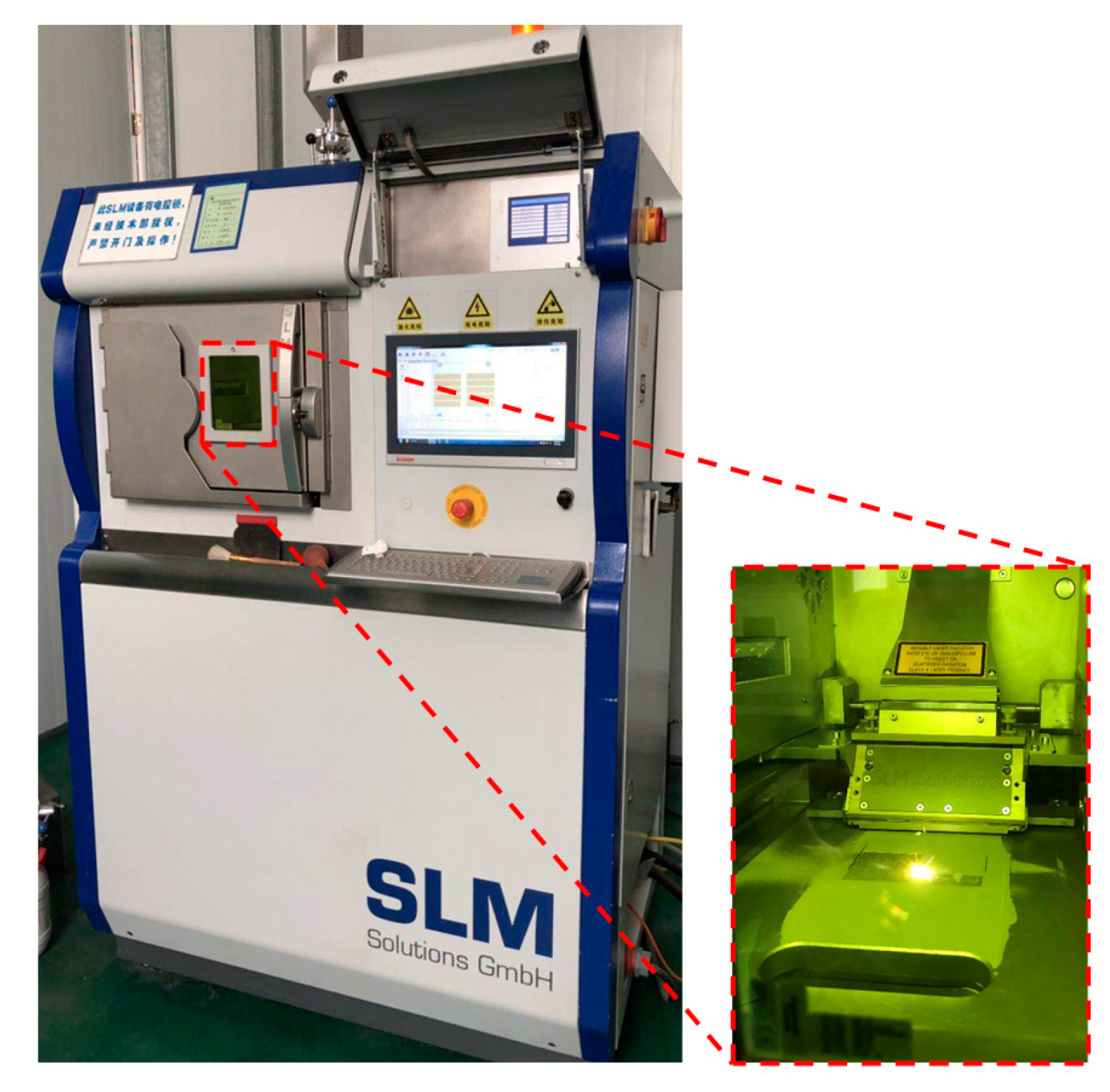

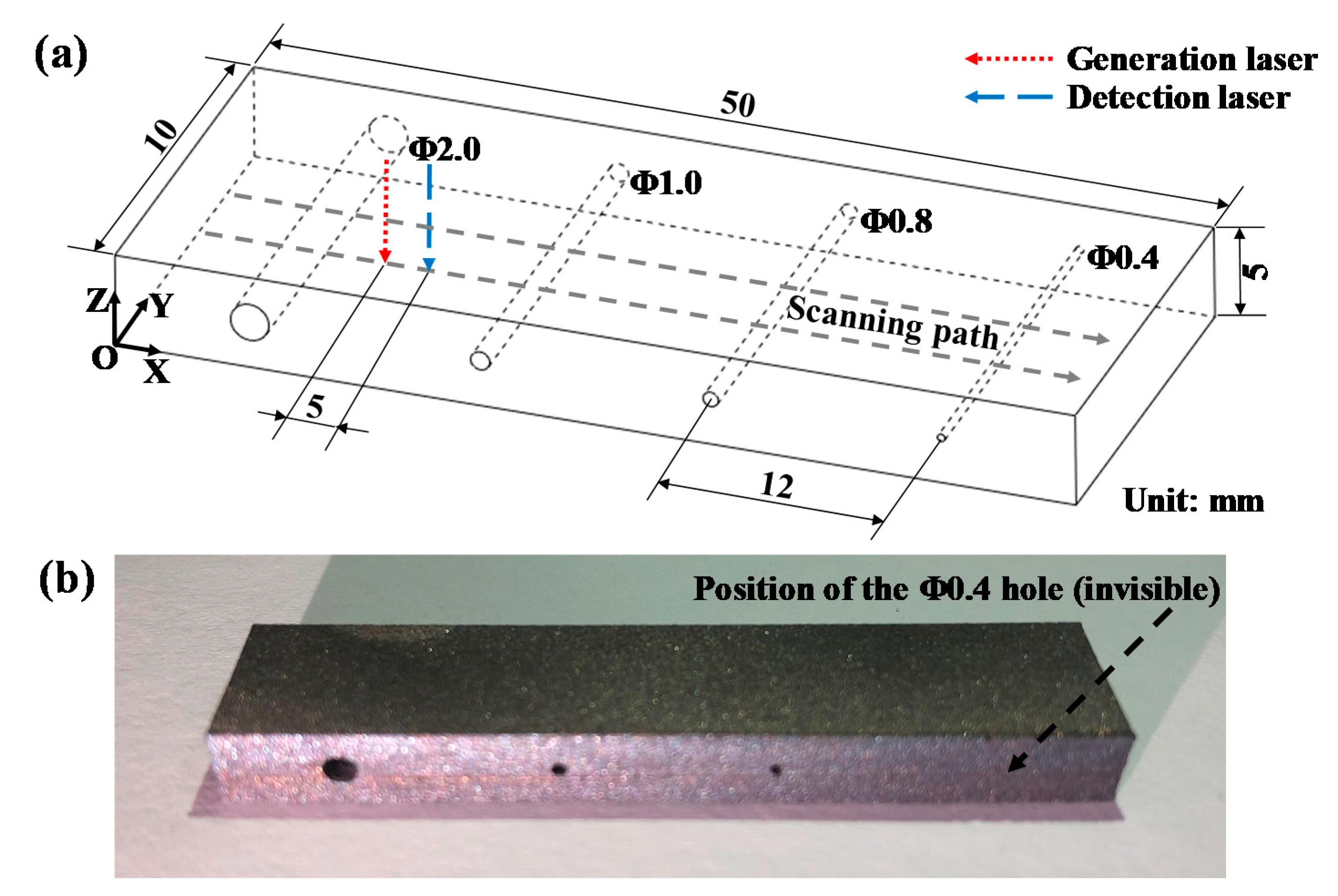
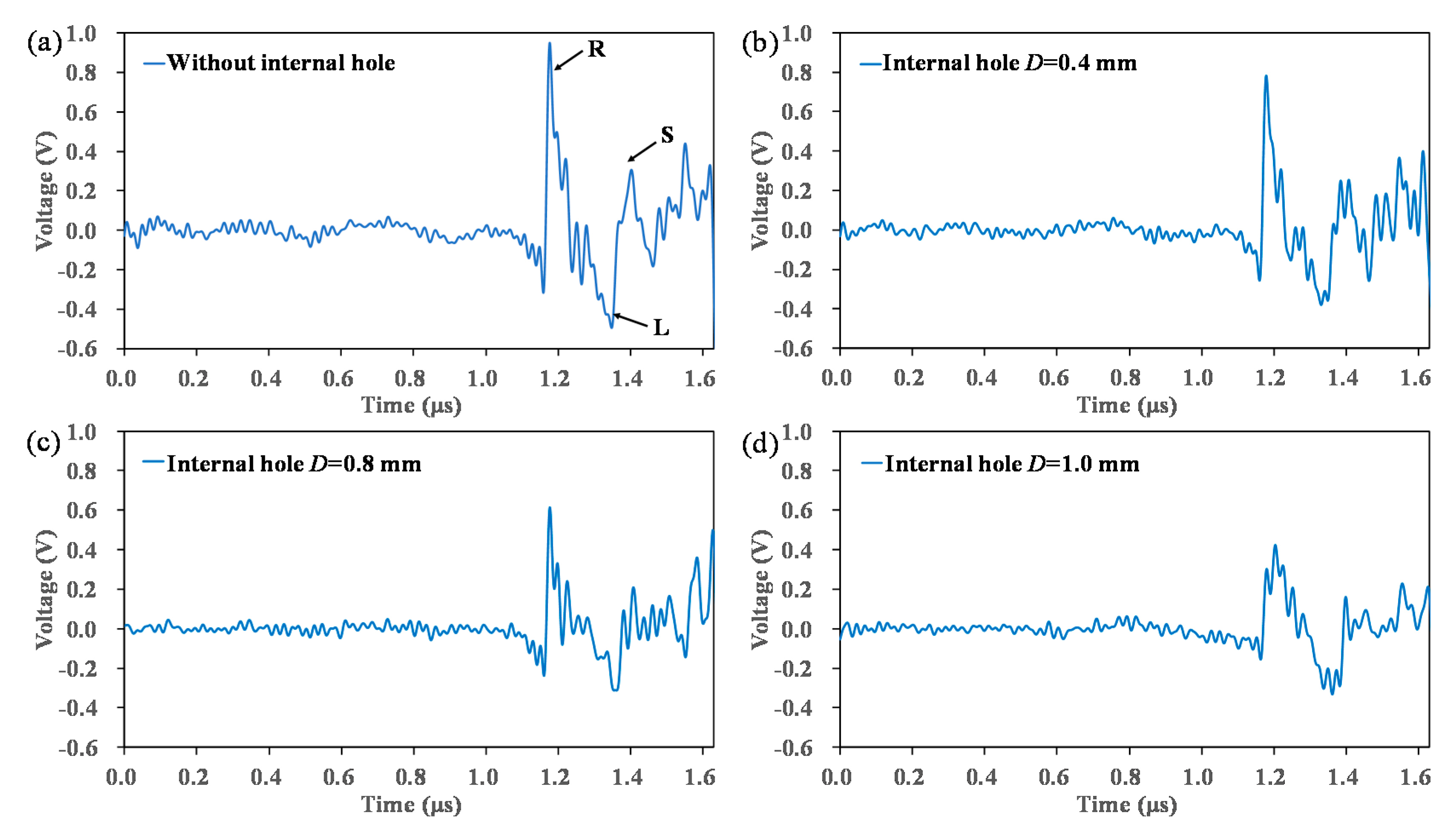

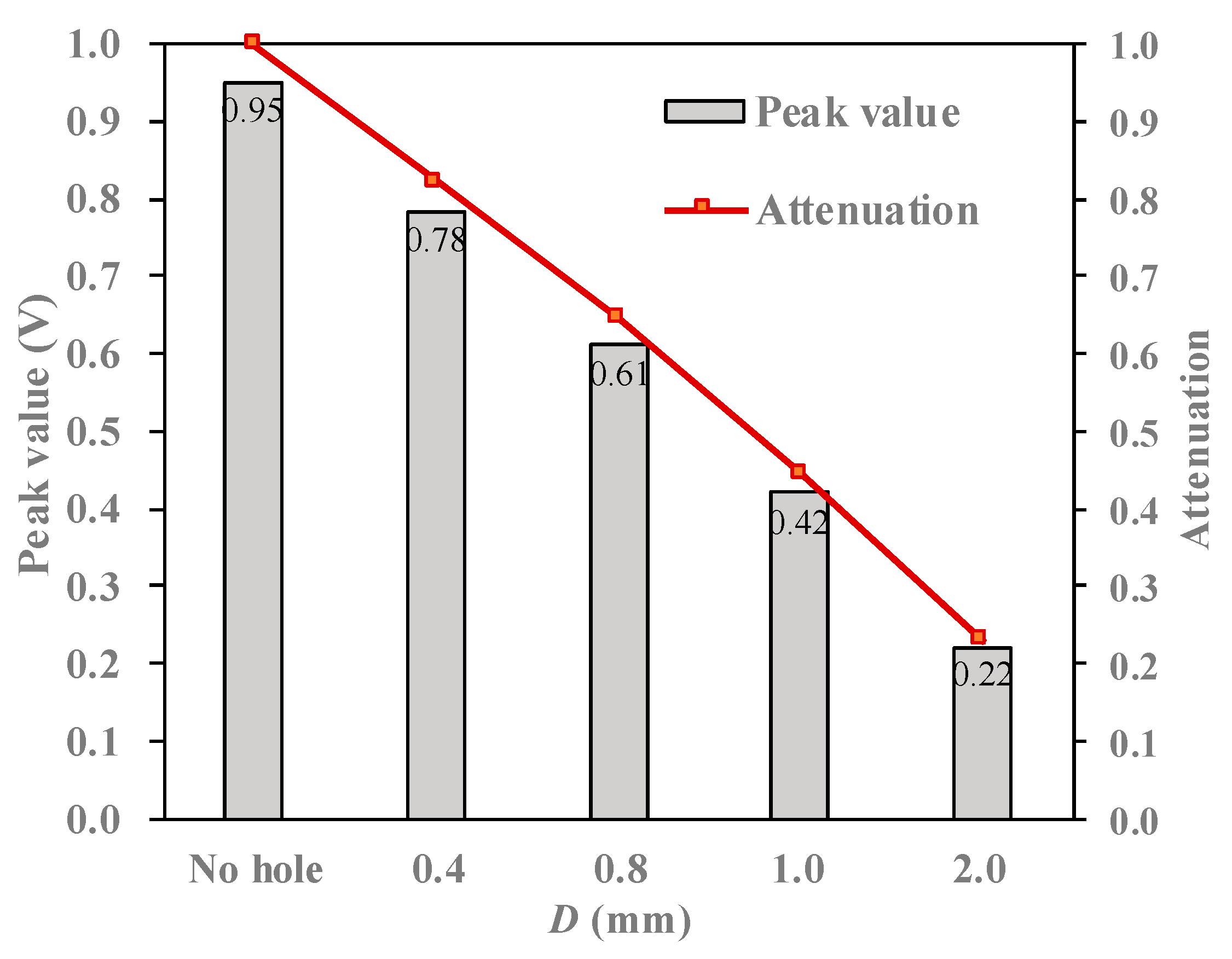
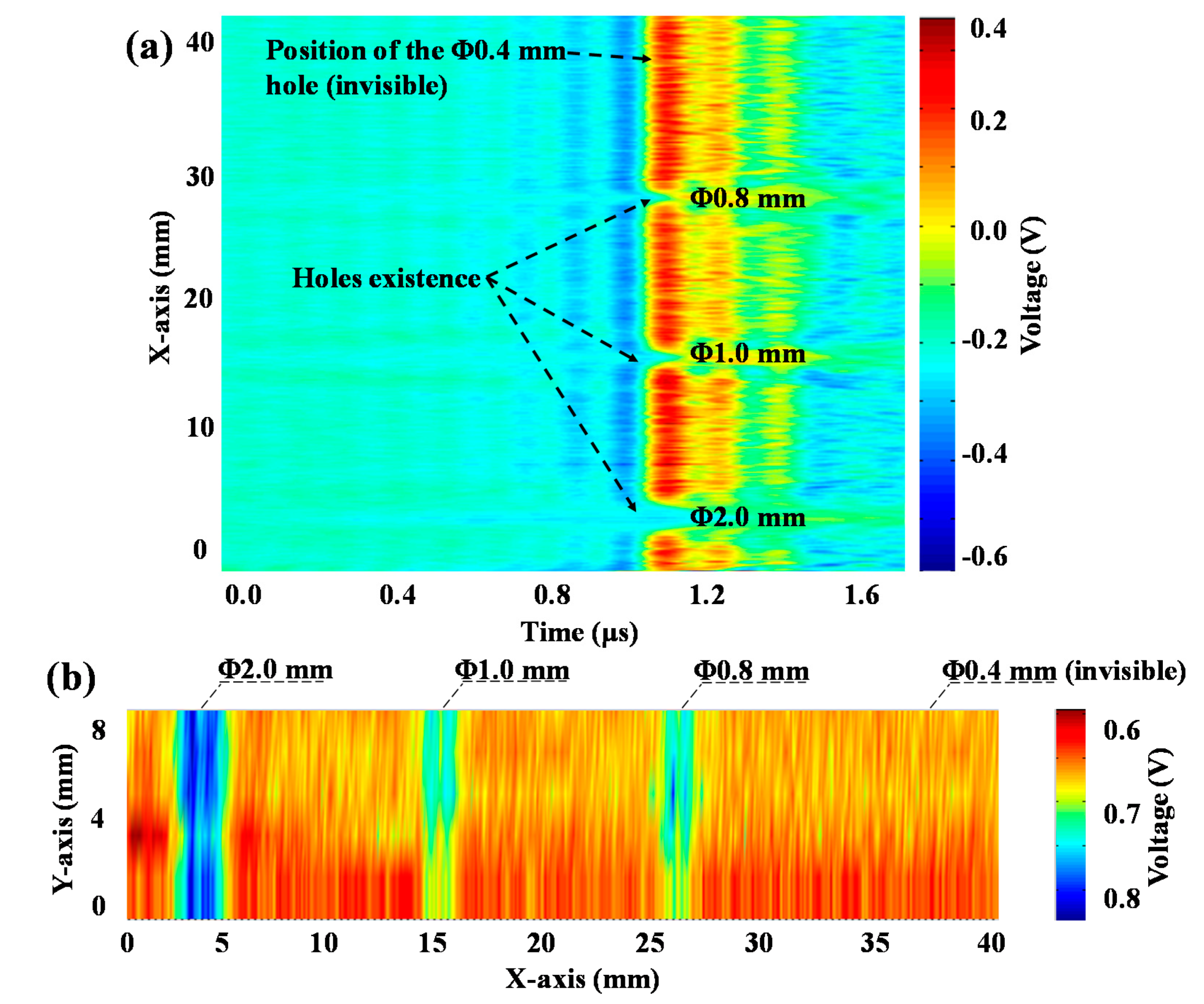

| Parameter (unit) | Value |
|---|---|
| Laser power (W) | 275 |
| Scanning speed (m/s) | 0.76 |
| Hatch spacing (mm) | 0.12 |
| Powder layer thickness (μm) | 50 |
| Generation Laser Parameters (Unit) | Value | Detection Laser Parameters (Unit) | Value |
|---|---|---|---|
| Wavelength (nm) | 532 | Wavelength (nm) | 532 |
| Laser diameter (mm) | 1 | Laser diameter (μm) | 25 |
| Laser energy (mJ/pulse) | 50 | Laser power (W) | 0.2 |
| Pulse width (ns) | 8 | Averaging number | 512 |
| Repetition frequency (Hz) | 20 | Scanning length (mm) | 40 |
| Scanning resolution (mm) | 0.1 | ||
| Index length (mm) | 8 | ||
| Index resolution (mm) | 0.2 |
| Parameter (Unit) | Value |
|---|---|
| Tube voltage (kV) | 220 |
| Tube current (μA) | 100 |
| Detector pitch (mm × mm) | 0.139 × 0.139 |
| Detector size (1pF VG1) | 1 × 1 |
| Detector binning | 1 × 1 |
| Tube mode | Microfocus |
| Resolution (μm) | 20 |
© 2020 by the authors. Licensee MDPI, Basel, Switzerland. This article is an open access article distributed under the terms and conditions of the Creative Commons Attribution (CC BY) license (http://creativecommons.org/licenses/by/4.0/).
Share and Cite
Yu, J.; Zhang, D.; Li, H.; Song, C.; Zhou, X.; Shen, S.; Zhang, G.; Yang, Y.; Wang, H. Detection of Internal Holes in Additive Manufactured Ti-6Al-4V Part Using Laser Ultrasonic Testing. Appl. Sci. 2020, 10, 365. https://doi.org/10.3390/app10010365
Yu J, Zhang D, Li H, Song C, Zhou X, Shen S, Zhang G, Yang Y, Wang H. Detection of Internal Holes in Additive Manufactured Ti-6Al-4V Part Using Laser Ultrasonic Testing. Applied Sciences. 2020; 10(1):365. https://doi.org/10.3390/app10010365
Chicago/Turabian StyleYu, Jie, Dongqi Zhang, Hui Li, Changhui Song, Xin Zhou, Shengnan Shen, Guoqing Zhang, Yongqiang Yang, and Hongze Wang. 2020. "Detection of Internal Holes in Additive Manufactured Ti-6Al-4V Part Using Laser Ultrasonic Testing" Applied Sciences 10, no. 1: 365. https://doi.org/10.3390/app10010365






